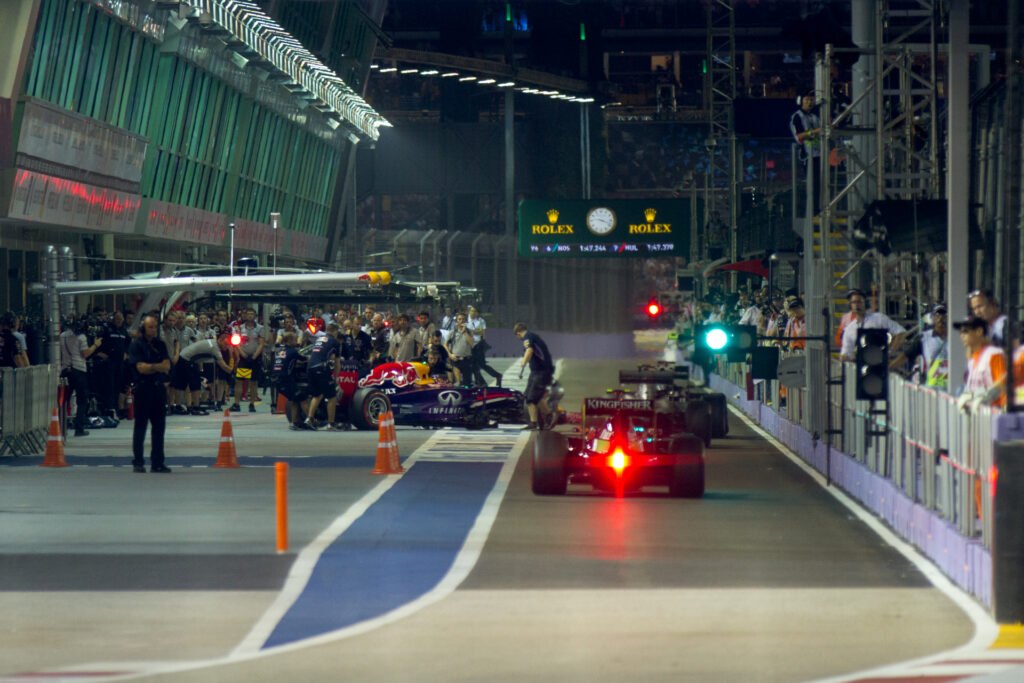Singapore Marina Bay Street Circuit

„The Home of Night Racing“

A Grand Prix Like No Other
The Marina Bay Circuit in Singapore, stretching 5.063 km, is one of the most intense tracks on the F1 calendar. Its rugged street surface, paired with Singapore’s high humidity, pushes drivers to their physical limits, making each lap a test of endurance and skill. With 19 demanding corners, drivers are constantly at the wheel, losing up to 4 kg in body weight over a single race. One of the circuit’s standout features is Turn 18, where drivers pass underneath a grandstand—a unique aspect in F1.

What Can You See On Your 3D Model?
Your 3D model of the Singapore Marina Bay Circuit isn’t just about the sleek curves and iconic night-time track. It also showcases the buildings and landmarks that make this location truly unique. Take a closer look, and you’ll discover so much more than you expected.

The iconic Marina Bay Sands stands out with its three towering structures connected by a rooftop terrace, home to the world’s largest infinity pool – 150 meters long. The complex rises to a height of 200 meters, making it one of the most recognizable features on your model. With 2,561 luxurious rooms, a shopping mall with over 300 shops, restaurants by world-renowned chefs, and a 15,000 m² casino, it’s a centerpiece that dominates the Marina Bay skyline.
Spanning 101 hectares, this futuristic park is a wonder to behold. On your model, you’ll see the iconic Supertrees – artificial tree structures that reach up to 50 meters tall. These trees don’t just look impressive; they collect rainwater, generate energy, and cool the surrounding area. The park also includes two massive greenhouses:
- The Flower Dome, the largest glass greenhouse in the world according to Guinness World Records, and
- The Cloud Forest, featuring a 35-meter waterfall, once the tallest indoor waterfall globally.
Known for its durian-like design (yes, the famous Southeast Asian fruit), this cultural hub opened in 2002 and stands out on your model with its distinctive architecture. The main concert hall seats 1,600 people, making it a hub for the arts and performances in Singapore.
This iconic observation wheel, standing at 165 meters, was the tallest in the world until 2014. Its 28 air-conditioned capsules can each accommodate 28 people, and a full rotation takes approximately 30 minutes. On your model, it’s positioned near the track, where it offers breathtaking views of the Marina Bay area and the Formula 1 action.
The largest floating stage in the world measures 120 x 83 meters and is also featured on your model. It’s used for concerts, national celebrations, and, during the F1 Grand Prix, as a hotspot for events and entertainment. With a capacity of 30,000 spectators, it’s a remarkable piece of engineering that deserves its place on your 3D replica.
Raffles Boulevard showcases a mix of modern skyscrapers and historical buildings. On your model, you’ll also spot the iconic Lau Pa Sat market, originally built in 1894. Today, it’s a famous food haven where both locals and tourists enjoy authentic Singaporean cuisine. This area highlights the unique blend of tradition and modernity in Marina Bay.
This stunning lotus-shaped building is one of Marina Bay’s most recognizable landmarks. On your model, you’ll find it located right by the circuit. Spanning 6,000 m² across 21 galleries, the museum is a symbol of the fusion of art, science, and technology. The building is also environmentally friendly, collecting rainwater that cascades through its center, creating a beautiful waterfall.
The history of Singapore comes alive on your model with landmarks such as the National Gallery Singapore, housed in the former Supreme Court and City Hall buildings. The gallery boasts over 8,000 artworks, making it one of the largest art collections in Southeast Asia. Nearby, the Padang is a historic site where key moments in Singapore’s journey to independence unfolded.

Racing Under the Lights
As F1’s only night race, the Marina Bay Circuit transforms into a glowing spectacle with over 1,600 custom-designed floodlights ensuring crystal-clear views for fans and drivers alike. This thrilling night-time ambiance sets the Singapore Grand Prix apart, making it a must-see for racing enthusiasts worldwide.
Each year, the track undergoes changes, from corner realignments to surface updates, to keep it both challenging and safe. Historic turns like Sheares and Memorial add a layer of character, while the re-profiling between Turns 16-19 at NS Square recently shortened the track length, cutting lap times by almost 20 seconds. Marina Bay Circuit is truly a blend of technical challenges and iconic turns, making it an unforgettable F1 experience for drivers and fans alike.
Interesting Facts
This circuit hosted the first-ever night race in F1 history in 2008, illuminated by over 1,600 floodlights that are four times brighter than standard stadium lighting.
Known for its bumpy surface, especially on Raffles Boulevard, the circuit demands immense physical effort. Lewis Hamilton described it as twice as challenging as the Monaco Grand Prix.
The Turn 10 chicane, dubbed the Singapore Sling, was notorious for its difficulty and risk of car damage. It was replaced in 2013 with a smoother left-hand corner for improved safety.
Singapore’s hot and humid climate adds an extra layer of difficulty, making the race one of the most physically demanding events for drivers. Drivers tend to lose up to 4kg of their wieght during the race.
Sebastian Vettel achieved a dominant victory in 2013, leading the race by over 32 seconds—a testament to his control on this demanding track.
The circuit uses customized lighting to minimize glare and reflections while meeting F1’s strict broadcasting standards.
As one of the longest races on the calendar, often approaching the two-hour time limit, it challenges teams and drivers to balance speed with endurance.
In 2022, significant resurfacing was done to minimize the porpoising effect caused by the new generation of F1 cars.
Circuit Guide
Video by LifeInTheFastLaneF1 on YouTube. Used in accordance with the YouTube embed permissions.
Shop Our 3D Models
Our exclusive 3D circuit models capture every turn and chicane in stunning details – perfect for any F1 fan.
-
Rated 0 out of 5€ 0,00
-
Rated 5.00 out of 5 based on 1 customer rating€ 0,00


